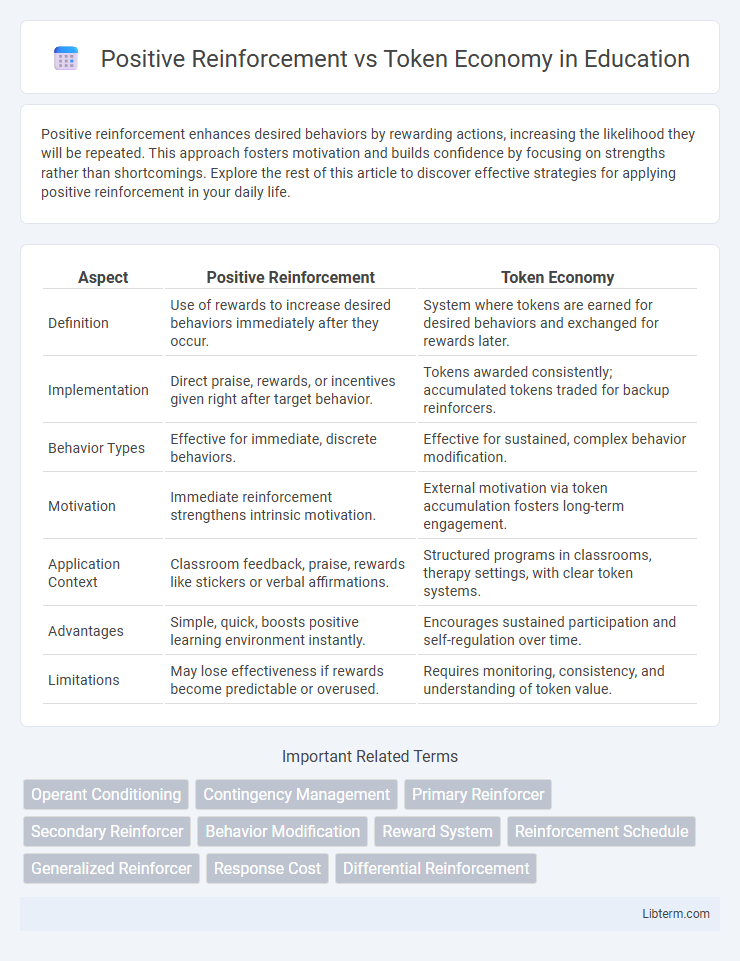Positive reinforcement enhances desired behaviors by rewarding actions, increasing the likelihood they will be repeated. This approach fosters motivation and builds confidence by focusing on strengths rather than shortcomings. Explore the rest of this article to discover effective strategies for applying positive reinforcement in your daily life.
Table of Comparison
| Aspect | Positive Reinforcement | Token Economy |
|---|---|---|
| Definition | Use of rewards to increase desired behaviors immediately after they occur. | System where tokens are earned for desired behaviors and exchanged for rewards later. |
| Implementation | Direct praise, rewards, or incentives given right after target behavior. | Tokens awarded consistently; accumulated tokens traded for backup reinforcers. |
| Behavior Types | Effective for immediate, discrete behaviors. | Effective for sustained, complex behavior modification. |
| Motivation | Immediate reinforcement strengthens intrinsic motivation. | External motivation via token accumulation fosters long-term engagement. |
| Application Context | Classroom feedback, praise, rewards like stickers or verbal affirmations. | Structured programs in classrooms, therapy settings, with clear token systems. |
| Advantages | Simple, quick, boosts positive learning environment instantly. | Encourages sustained participation and self-regulation over time. |
| Limitations | May lose effectiveness if rewards become predictable or overused. | Requires monitoring, consistency, and understanding of token value. |
Understanding Positive Reinforcement
Positive reinforcement strengthens behavior by presenting a rewarding stimulus immediately after the desired action, increasing the likelihood of its recurrence. It relies on intrinsic or extrinsic rewards such as praise, treats, or privileges to motivate individuals effectively. Understanding positive reinforcement is essential before implementing token economy systems, as it forms the foundational principle for behavior modification through consistent, meaningful rewards.
What Is a Token Economy?
A token economy is a behavioral management system that uses tokens as conditioned reinforcers, which individuals earn by exhibiting desired behaviors and later exchange for meaningful rewards. This method structures motivation by providing immediate feedback and tangible incentives, enhancing engagement and behavior modification. Unlike general positive reinforcement, token economies create a systematic exchange process that fosters sustained behavioral change through consistent reinforcement.
Core Principles of Positive Reinforcement
Positive reinforcement is a behavioral technique that increases the likelihood of a desired behavior by immediately following it with a rewarding stimulus, such as praise or a tangible reward. Core principles include immediacy, consistency, and specificity, ensuring that the reinforcement directly relates to the targeted behavior to strengthen it effectively. Unlike token economies, which use symbolic tokens exchanged for rewards later, positive reinforcement emphasizes direct and immediate responses to encourage behavior change.
How Token Economy Systems Operate
Token economy systems operate by providing tokens as conditioned reinforcers that can be exchanged for backup reinforcers like privileges, goods, or services. These systems use a structured schedule for earning tokens based on target behaviors, promoting consistent positive behavior change through immediate feedback. Token economies are commonly implemented in educational settings, therapy programs, and correctional facilities to enhance motivation and behavioral compliance.
Key Differences: Positive Reinforcement vs Token Economy
Positive reinforcement involves directly rewarding a desired behavior immediately after it occurs to increase the likelihood of repetition, often using praise or tangible rewards. A token economy system uses tokens as secondary reinforcers, which individuals collect and later exchange for primary rewards, allowing for delayed gratification and structured behavior management. The key difference lies in positive reinforcement providing immediate, specific reward, whereas token economy employs a two-step process involving token accumulation and exchange.
Benefits of Positive Reinforcement
Positive reinforcement enhances learning by immediately encouraging desirable behaviors, increasing the likelihood of repetition through rewards such as praise or tangible incentives. It fosters intrinsic motivation, improves self-esteem, and strengthens the bond between the individual and the instructor or caregiver. Positive reinforcement is widely effective across diverse settings, including classrooms, therapy, and workplaces, promoting sustained behavioral change without reliance on external tokens.
Advantages of Implementing a Token Economy
Implementing a token economy enhances motivation by providing immediate, tangible rewards that reinforce desired behaviors. This system facilitates clear tracking and quantification of progress, which supports consistent behavior modification across diverse settings. Token economies also improve engagement and promote long-term habit formation by linking tokens to meaningful reinforcers tailored to individual preferences.
Drawbacks and Limitations of Each Approach
Positive reinforcement can sometimes lead to dependency on external rewards, reducing intrinsic motivation and making behavior maintenance challenging when rewards are withdrawn, particularly in long-term applications. Token economies require rigorous structure and consistency, often demanding significant time and resource investment from educators or therapists, and may be less effective for individuals who struggle to understand the symbolic value of tokens. Both approaches risk diminishing natural social interactions and may not address underlying behavioral issues without complementary strategies targeting intrinsic motivation and skill development.
Practical Applications in Education and Therapy
Positive reinforcement involves directly rewarding desired behaviors to increase their frequency, commonly used in classrooms to encourage participation and academic achievement. Token economies utilize a system where tokens are earned for specific behaviors and later exchanged for meaningful rewards, effectively promoting pro-social behavior and skill development in therapy settings. Both methods enhance motivation and behavior modification by providing structured, consistent incentives tailored to individual needs in educational and therapeutic environments.
Choosing the Right Strategy for Behavioral Change
Positive reinforcement involves directly rewarding desired behaviors to increase their frequency, making it effective for immediate behavioral changes. Token economy systems use symbolic tokens exchanged for rewards, fostering sustained motivation through delayed gratification and structured reinforcement schedules. Selecting the right strategy depends on factors like the complexity of behavior, environment, and individual preferences to ensure optimal behavioral modification outcomes.
Positive Reinforcement Infographic

 libterm.com
libterm.com